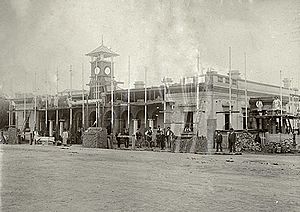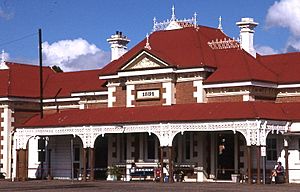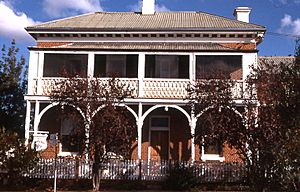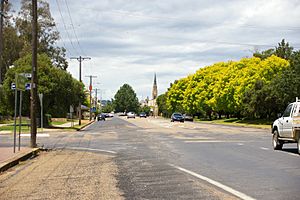Mudgee facts for kids
Quick facts for kids MudgeeNew South Wales |
|||||||||
|---|---|---|---|---|---|---|---|---|---|
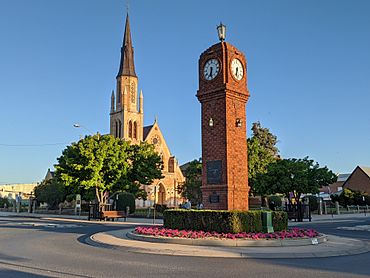
View of the town centre, showing War Memorial Clock Tower
|
|||||||||
| Population | 11,457 (2021) | ||||||||
| Postcode(s) | 2850 | ||||||||
| Elevation | 454 m (1,490 ft) | ||||||||
| Location |
|
||||||||
| LGA(s) | Mid-Western Regional Council | ||||||||
| Region | Central West | ||||||||
| County | Wellington | ||||||||
| State electorate(s) | Dubbo | ||||||||
| Federal Division(s) | Calare | ||||||||
|
|||||||||
Mudgee (pronounced MUD-jee) is a lively town located in the Central West region of New South Wales, Australia. It sits in the wide, fertile valley of the Cudgegong River, about 261 kilometres (162 miles) north-west of Sydney. Mudgee is the biggest town in the Mid-Western Regional Council area and is also where the council's main office is located. In 2021, the town had a population of 11,457 people. The area is also known for its interesting geology, sitting on the edge of the Sydney Basin.
Contents
- Exploring Mudgee's Past: A Journey Through Time
- Mudgee's Economy: How the Town Works
- Who Lives in Mudgee? A Look at the Population
- Mudgee's Weather: What's the Climate Like?
- Historic Buildings in Mudgee: A Glimpse into the Past
- Places of Worship in Mudgee
- Schools and Colleges in Mudgee
- Notable People from Mudgee
- Images for kids
Exploring Mudgee's Past: A Journey Through Time
Who Were the First People of Mudgee?
Long before European settlers arrived, the Mudgee area was home to the Wiradjuri people, specifically the Mudgee and Dabee clans. They lived along and around the Cudgegong River. Even today, you can find special places where these Aboriginal people created tools and left cultural marks. These include sites like Hands on the Rocks, The Drip, and Babyfoot Cave.
What Do Mudgee's Place Names Mean?
Many of the names for places in the Mudgee region come from the original Wiradjuri language. The name "Mudgee" itself was given by the Wiradjuri clan who lived there. It has several possible meanings, such as "resting place," "contented," "nest in the hills," or even "friend or mate." The correct way to say it has been recorded as Moudgee, Moothi, or Mougee.
Other nearby place names also have Wiradjuri meanings:
- Lue (Loowee) means 'a chain of waterholes'.
- Gulgong means 'a gully'.
- Wollar means 'a rock water hole'.
- Menah means 'flat country'.
- Eurunderee means 'a local tree'.
- Guntawang means 'a peaceful place'.
- Cooyal means 'dry country'.
- Wilbertree means 'a long switch'.
- Gooree means 'native chasing live animal'.
- Burrendong means 'darker than usual'.
The Aboriginal name for the Rylstone area was Combamolang.
Early European Settlement in Mudgee (1821-1850)
In 1821, James Blackman was the first British explorer to reach the Mudgee area. Soon after, Lieutenant William Lawson, who was in charge at Bathurst, also explored Mudgee. Both found that the area was an Aboriginal settlement, or bimmel, with about 100 people who called it Mudgee or Mujjee.
In 1822, George and Henry Cox, sons of William Cox, brought 500 livestock to the area and started a grazing farm at Menah, about 3 kilometres (1.9 miles) north of the current town. There were some early conflicts between the settlers and the Mudgee clan over land and resources.
The Mudgee town site was officially surveyed in 1837, and the first land was sold in 1838. John Blackman built the first house and general store in Mudgee. By 1841, Mudgee had grown to include 36 homes, three hotels, a hospital, a post office, two stores, and an Anglican church. The police station also moved to Mudgee in the mid-1840s.
Mudgee's Growth from 1850 to Today
In 1851, Mudgee had a population of 200 people. This number quickly grew when Edward Hargraves discovered gold nearby in Hargraves. While Mudgee itself didn't have gold, it became a central hub for goldfields like Gulgong, Hill End, and Windeyer. This made Mudgee grow very fast.
Mudgee became an official municipality in 1860, making it the second oldest town council west of the Great Dividing Range. By 1861, its population was 1,500. During this time, a public school and new churches were built. A new police station, courthouse, and town hall were also constructed in the 1860s. Many of these historic buildings, like the Mudgee Museum and the courthouse, are now protected by the National Trust of Australia. In 1861, the Electric Telegraph system arrived, allowing messages to be sent and received.
One gold miner who came to the Mudgee area was Niels Peter Larsen. He and his wife, Louisa Albury, were the parents of the famous Australian poet Henry Lawson. Henry Lawson was born in Grenfell in 1867, but his family later moved to a farm near Mudgee called Pipeclay (now Eurunderee), about 8 kilometres (5 miles) north of town. This spot is now a rest stop with a special plaque.
Louisa Lawson worked hard to help set up the Eurunderee Public School in 1876, which Henry Lawson attended at age nine. He later wrote about this school in his poem, The Old Bark School. Henry Lawson lived in the Mudgee region until he was 15, and many of his stories are inspired by the area.
Although tiny diamonds were sometimes found by gold panners, a much larger diamond, weighing 22.2 carats, was discovered near the Cudgegong River in 1869. It was called the "Mudgee diamond" and was the biggest found in Australia at that time. However, large amounts of diamonds were not found, so companies formed to mine them eventually closed.
As the gold rush slowed down in the late 1800s, Mudgee continued to thrive thanks to its wool industry and a growing wine industry, started by German immigrant Adam Roth in the 1850s. The railway line reached Mudgee in 1884, which greatly helped the town's agriculture.
Mudgee is also a place for sports! The Glen Willow Regional Sports Stadium has hosted big rugby league matches, including the City vs Country Origin games. The St. George Dragons rugby league team also plays some of their home games there. In soccer, the Western Sydney Wanderers team has chosen Mudgee for some of their community matches.
Mudgee's Economy: How the Town Works
Mudgee is well-known for its wine production, and it also has industries that make and repair things. The town's economy is also strongly supported by several large mines in the surrounding area. Many miners live in Mudgee but travel to work at these mines.
Other important farm products from the area include cattle, sheep, wheat, alfalfa, olives, fruit, tomatoes, sweetcorn, honey, alpacas, and dairy products. However, mining plays a bigger role in the economy.
The Ulan coal mines are located in the district, and Mudgee also produces marble, pottery clays, shale, and dolomite. These mines have the potential to grow, but their expansion sometimes leads to environmental discussions.
Tourism is also a growing industry, mainly because of the beautiful wineries. Many people from Sydney have also moved to Mudgee, especially since 2020, looking for a different lifestyle. This has caused property prices to increase. Mudgee also has a local airport, making it easy to fly to Sydney in about an hour.
In 1987, a special laboratory was set up in Mudgee to test meat for any unwanted substances. A new hospital was also completed in 2020, providing modern healthcare for the community.
Who Lives in Mudgee? A Look at the Population
According to the 2021 Census:
- Mudgee had a population of 11,457 people.
- About 7.5% of the population identified as Aboriginal and Torres Strait Islander people.
- Most people (86%) were born in Australia. Other countries of birth included England (2.1%), New Zealand (0.9%), and the Philippines (0.5%).
- Over half the population (56.5%) are Christian, with Catholic (24%) and Anglican (18.9%) being the largest groups. About 37.8% of people stated they had no religion.
- English is the main language spoken at home by 89.7% of people. Other languages spoken include Nepali (0.4%), Punjabi (0.4%), and Tagalog (0.3%).
- The average weekly household income was $1,678.
| Historical population | ||
|---|---|---|
| Year | Pop. | ±% |
| 1921 | 3,170 | — |
| 1933 | 3,993 | +26.0% |
| 1947 | 4,178 | +4.6% |
| 1954 | 5,294 | +26.7% |
| 1961 | 5,312 | +0.3% |
| 1966 | 5,372 | +1.1% |
| 1971 | 5,598 | +4.2% |
| 1976 | 5,724 | +2.3% |
| 1981 | 6,015 | +5.1% |
| 1986 | 6,576 | +9.3% |
| 1991 | 7,447 | +13.2% |
| 1996 | 8,195 | +10.0% |
| 2001 | 8,603 | +5.0% |
| 2006 | 8,249 | −4.1% |
| 2011 | 9,830 | +19.2% |
| 2016 | 10,966 | +11.6% |
| 2021 | 11,563 | +5.4% |
| Source: Australian Bureau of Statistics data. | ||
Mudgee's Weather: What's the Climate Like?
Mudgee has a humid subtropical climate (Cfa), which means it has warm, humid summers and mild winters. Summers are hot and often have strong thunderstorms. Winters are quite cold, with frosty mornings but usually sunny days. Sometimes it rains, and very rarely, it snows. The heaviest snowfall ever recorded in Mudgee was 1 foot 10 inches (56 cm) on July 5, 1900.
Rainfall is moderate and spread fairly evenly throughout the year, with a little more rain in summer. Temperatures in Mudgee have ranged from a very cold -8.3°C (17.1°F) to a very hot 43.9°C (111.0°F). Mudgee enjoys about 113 clear days each year.
| Climate data for Mudgee (George Street, 1907–1995, rainfall 1870–2022); 454 m AMSL; 32.60° S, 149.60° E | |||||||||||||
|---|---|---|---|---|---|---|---|---|---|---|---|---|---|
| Month | Jan | Feb | Mar | Apr | May | Jun | Jul | Aug | Sep | Oct | Nov | Dec | Year |
| Record high °C (°F) | 42.5 (108.5) |
43.9 (111.0) |
37.2 (99.0) |
34.5 (94.1) |
26.1 (79.0) |
22.8 (73.0) |
22.2 (72.0) |
26.8 (80.2) |
32.2 (90.0) |
38.2 (100.8) |
40.2 (104.4) |
40.6 (105.1) |
43.9 (111.0) |
| Mean daily maximum °C (°F) | 31.0 (87.8) |
30.2 (86.4) |
27.8 (82.0) |
23.3 (73.9) |
18.8 (65.8) |
15.2 (59.4) |
14.4 (57.9) |
16.0 (60.8) |
19.6 (67.3) |
23.4 (74.1) |
26.9 (80.4) |
29.8 (85.6) |
23.0 (73.4) |
| Mean daily minimum °C (°F) | 15.5 (59.9) |
15.4 (59.7) |
13.0 (55.4) |
8.5 (47.3) |
5.0 (41.0) |
2.6 (36.7) |
1.3 (34.3) |
2.3 (36.1) |
4.4 (39.9) |
7.6 (45.7) |
10.8 (51.4) |
13.7 (56.7) |
8.3 (46.9) |
| Record low °C (°F) | 3.4 (38.1) |
4.0 (39.2) |
2.0 (35.6) |
−2.7 (27.1) |
−5.6 (21.9) |
−7.5 (18.5) |
−8.3 (17.1) |
−5.7 (21.7) |
−3.2 (26.2) |
−2.3 (27.9) |
0.5 (32.9) |
2.0 (35.6) |
−8.3 (17.1) |
| Average rainfall mm (inches) | 67.7 (2.67) |
63.9 (2.52) |
51.1 (2.01) |
44.2 (1.74) |
49.4 (1.94) |
54.5 (2.15) |
52.9 (2.08) |
53.1 (2.09) |
52.0 (2.05) |
60.0 (2.36) |
62.1 (2.44) |
65.3 (2.57) |
676.2 (26.62) |
| Average rainy days (≥ 0.2mm) | 6.1 | 5.9 | 5.3 | 4.7 | 6.3 | 8.0 | 8.3 | 7.8 | 7.2 | 7.4 | 6.8 | 6.5 | 80.3 |
| Average afternoon relative humidity (%) | 40 | 47 | 46 | 50 | 56 | 58 | 57 | 52 | 47 | 45 | 41 | 40 | 48 |
| Source: Bureau of Meteorology | |||||||||||||
Historic Buildings in Mudgee: A Glimpse into the Past
Mudgee has many buildings that are listed for their historical importance. These include:
- 5–7 Church Street: Regent Theatre
- 13 Church Street: St Mary's Roman Catholic Church
- 64 Market Street: Mudgee Town Hall
- 80 Market Street: Mudgee Post Office
- 111 Lester's Lane: Binnawee Homestead
- Wallerawang-Gwabegar railway: Mudgee railway station
Places of Worship in Mudgee
Mudgee has several churches for different faiths:
- St John's Anglican Church
- St Mary's Catholic Church
- St Paul's Presbyterian Church
- Mudgee Uniting Church
- Frontline Assemblies of God
- Mudgee Baptist Church
- Salvation Army
- Seventh Day Adventist Church
Schools and Colleges in Mudgee
Mudgee offers a variety of schools and colleges for students:
- Cudgegong Valley Public School
- Mudgee High School
- Mudgee Public School
- St Matthews Catholic School
- Mudgee College (TAFE)
Notable People from Mudgee
Many interesting people have connections to Mudgee:
- Natarsha Belling – a national newsreader for Channel 10.
- Felicity Brown – a talented hat designer.
- Kim Currie – a chef and restaurant owner, who won NSW Rural Woman of the Year in 2009.
- Ivan Dougherty – an Australian army officer who attended Mudgee High School.
- Jamie Fitzgerald – a former professional rugby league player.
- John Floreani - the lead singer of the rock band Trophy Eyes.
- Kevin Golsby – an actor and host for radio and television.
- Darrell Hair – an international cricket umpire.
- Lisa Keightley – a cricketer, and the first woman to score a century (100 runs) at Lord's in England.
- Henry Lawson – one of Australia's most famous poets and short story writers. He lived in Mudgee for 16 years during his childhood.
- Louisa Lawson – Henry Lawson's mother, who was also a strong activist.
- David Lowe – a winemaker and president of the NSW Wine Industry Association.
- The Massey family of organists — a family of musicians born in Mudgee.
- Scott McGregor – an Australian actor, TV presenter, and railway historian.
- Ted Noffs – a Methodist minister who founded the Wayside Chapel in Kings Cross.
- James Stanton – an Olympic water polo player for Australia.
- Ken Sutcliffe – a well-known television personality and sports reader.
- Dennis Talbot – a professional boxer who represented Australia in the 1972 Olympics.
- Gil Wahlquist – a pioneer in organic winemaking.
- Groups
- Brothers3 – music contestants from X-Factor in 2014.
Images for kids



